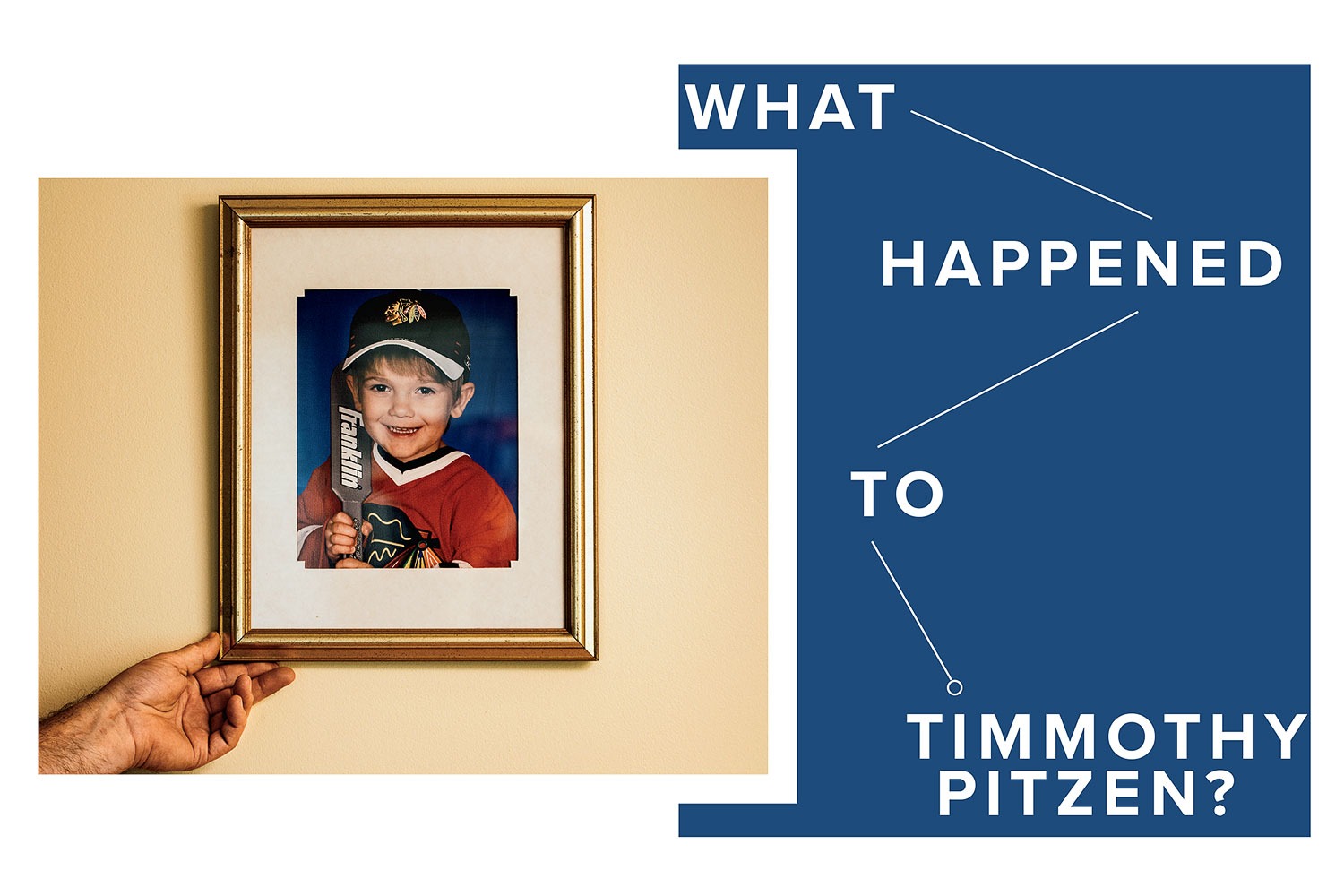The dream still comes to him even now, 10 years later. The images that unspool in his mind are always the same, but the trigger is as unpredictable as lighting. He could have drifted off reminiscing on happy times or feeling hopeful of a reunion, or he may have slipped off fighting despair and darkness. Sometimes he won’t have been thinking about the situation at all. Then, poof. There she is in his deep slumber. Amy. Alive.
She stands in front of him, her dark eyes staring, her familiar features framed by her dark hair. He feels his anger rising. He grabs her shoulders and shakes. “What did you do? Where is he?” She looks back at him. Nothing. He asks again, begs. “Where is he? Where is Tim?” But the mother just stares until her image fades and she is gone, having again not answered.

It is raining the day I pull into Clinton, Iowa, an industrial town hard against the west bank of the Mississippi River. Once known as the lumber capital of the world, a place with more millionaires per capita than anywhere in the country, it is now home to a largely working-class population of 25,000.
Jim Pitzen was born and raised here, and it was to Clinton that he retreated after everything happened. He and his wife and his 6-year-old son, Timmothy, had been living in another river town at the time, this one cleaved in half by the Fox River in west suburban Chicago, a little more than 100 miles east of Clinton.
Jim had tried to stay in that Aurora home. For all the tragedy associated with it, the small house with the wood-railed front porch still held cherished memories, some of the last that the father had of his son: Tim playing with his Matchbox cars; circling the front driveway on his bike; cuddling with his gray cat; goofing around in the yard with the family’s black Lab. The father had just started building the boy a treehouse out back.
But as the days passed, the bad memories crowded out the good, the daily reminders of the unthinkable acts of his wife, Tim’s mother: how she had absconded with their son, keeping their whereabouts secret for days, then checking into a Rockford motel and sliced her own wrist and neck, leaving behind a cryptic, staggering note saying that she had given her son to people who would love and care for him but that he would never be found.
And so the father fled the home, the life he’d known, and the treehouse he couldn’t bear to finish. “The way the other house felt … ,” he says, then pauses. “ … I just had to get out of there.”
Ten years on, true to his mother’s words, Timmothy Pitzen still has not been found, and the enduring mystery haunts his father almost every hour of every day. On this afternoon, Jim sits in his living room in Clinton, looking at his hands. The room is so quiet you can hear the patter of the rain that has been falling steadily, drumming on the stripped chassis of an old tomato-colored pickup and the husk of a convertible MG half hidden on a patch of the overgrown front yard. The vehicles are projects he’s taken on over the years to take his mind off the gnawing anguish. He tinkers with them less and less of late, so they now rest like neglected tombs, slowly rusting.
He is in the process of fixing up the home, he says, so some drywall and paint cans clutter a hallway. On the way to the living room, I caught a glimpse of his bedroom, the door to which stood unapologetically open. The unmade bed was buried under a jumble of shirts and socks. It looked like the unkempt room of a teenager, a 16-year-old maybe, the age his son would be today. For a long time, Tim’s moon-face night-light had hung on Jim’s bedroom wall, but the pain of seeing it often led him to take it down. Jim walked me past that chaotic room with an utter lack of self-consciousness that seemed in keeping with a man of few words, not easily given to outward emotion. Still, his eyes fill and his voice thickens at times when he speaks of his son.
Jim folded his 6-foot-1 frame into a comfortable-looking chair. He wears a dark, loose-fitting long-sleeved T-shirt over jeans, a ball cap thumbed back on his head. Across from him is an old piano that hasn’t been played in years; to his left, a busted Ms. Pac-Man arcade game, its acrylic top a film of dust. To one side, framed photographs of Tim and his crooked, dimpled grin cover nearly every inch of the wall: donning a Blackhawks jersey, light brown bangs peeking from under a cap; beaming while sitting cross-legged in a spare tire, resting his head on the cat.
Ten years on, true to his mother’s words, Timmothy Pitzen still has not been found, and the enduring mystery haunts his father most every hour of every day.
“He was super smart, high energy, funny,” the father says, leaning forward. The way his boy ran, with a funny little waddle-shuffle “like a chubby old man,” always made Jim chuckle. “I had a go-kart in the back shed, and when Tim was about 3, I made the gas pedal so you couldn’t push it all the way down. He was out in the backyard just buzzing doughnuts.”
He could be a handful, the dad says. Tim’s parents bought him a bike with the stipulation that he was to ride it only in front of the house. “So one day he comes in and goes, ‘Did you miss me?’ ” Jim recalls. “I’m like, ‘What do you mean?’ He goes, ‘I rode to my friend’s house down the street.’ ” Jim did the only thing a dad could do in such a moment: shook his head and laughed. But he and Amy also taught Tim how to dial 911, and Jim insisted on getting him a child identification card that included his fingerprint in case he ever got lost.
The unanswered question of what Amy Fry-Pitzen did with Tim has left a trail of shattered lives and baffled detectives who continue to work the case to this day. After a decade, there is nothing concrete to indicate that Tim is still alive. Yet there is also nothing to indicate that he’s not, other than the echoing silence. The enigma has spawned hundreds of amateur sleuths obsessed with trying to solve the mystery that local, state, and federal law enforcement officials have not. And most painful of all, it has left a father frozen in a sort of nightmarish haze, unable to fully move on, insisting, despite not much more than his gut hope and faith, that his son is fine and will be returned to him one day.
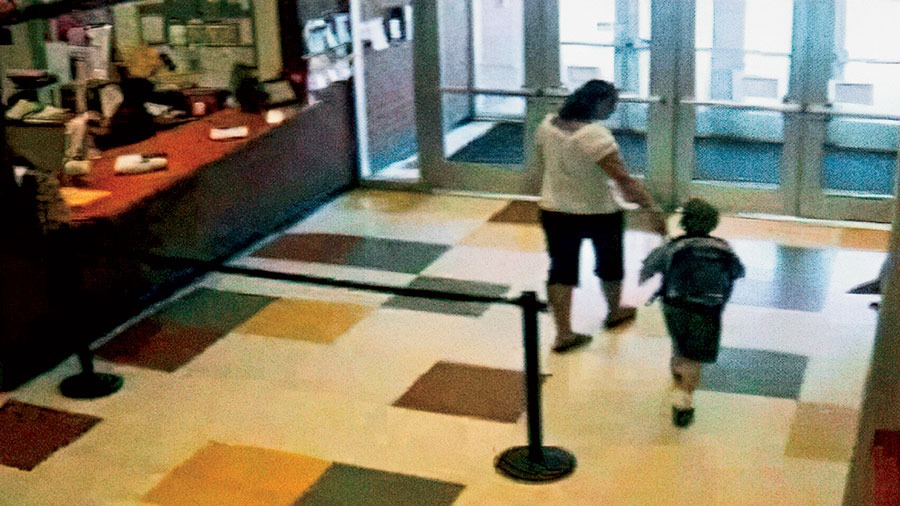
The nightmare began on May 11, 2011, which dawned as an otherwise unremarkable day for the family. The couple — Jim was 39 at the time, Amy 43 — had been fighting in the weeks leading up to that day. Really, for much of their seven-year marriage.
The arguments could be over anything. Something Jim did. Something he didn’t do — an errand she’d asked him to run that he’d forgotten. This one centered on a birthday trip to the Bahamas that Amy had taken the prior week with her best friend. Jim was rankled that his wife had insisted on just the two women going — not Jim or Tim. “You can’t stop me,” Jim recalls her telling him.
At times, the issues they fought over were quite serious. They nearly divorced in 2008 when Jim discovered texts between his wife and one of her three ex-husbands discussing plans for a rendezvous while Jim was out of town. “They’d had lunch a couple of times,” Jim says, “and they were supposed to meet that weekend. I told her to make up her mind: ‘If you want to be with that guy, go be with that guy. We’ll get a divorce, and I don’t care how much money your dad has, I’ll find a way to get custody of Timmothy.’ ” Of all the harsh words they’d spoken to each other, that threat struck Amy hardest. One of her fears was that a judge would take Tim from her and grant Jim custody because she had a history of mental health issues, says her younger sister, Kara Jacobs: “That terrified her.”
Amy decided to stay, Jim says, “but I told her, ‘If I find another text to your ex, we’re done.’ ” As far as he knows, they had no further contact.
To outsiders, his wife seemed happy — affable and always smiling, attributes that had first attracted Jim. They had met in late 2002 at a going-away party for Amy in Ames, Iowa. She had been working there after graduating from Iowa State but was now moving to Antioch, Illinois, where her mom lived after divorcing Amy’s father. Jim had come to Ames after finding temp work at a water treatment business, and a friend had asked him to come along to the party.
The two hit it off, despite differences in their personalities. She was smart and outgoing, enjoyed parties and traveling, and had a passion for reading. He was educated, too — he went to the Morrison Institute of Technology in Morrison, Illinois — but saw himself as just a regular guy who liked the Blackhawks, fixing up old Jeeps,and grabbing a beer with a buddy now and then.
Jim asked Amy out the day after the party. Soon they were seeing each other regularly. After Jim helped her move to Antioch, they began a long-distance relationship, with Jim making the drive every couple of weeks.
“I think, at her core, she was just unhappy. … The counseling, the medication — none of it really worked.”
— Kara Jacobs, Amy Fry-Pitzen’s sister
He learned some unsettling things about his new girlfriend. For one, she had been divorced three times. More concerning, she had a history of depression, with spells that could send her spiraling. She had twice attempted suicide. The first time, before she’d met Jim, she had parked her car on some train tracks, reconsidering only at the last moment. She told Jim that afterward she’d checked herself into a psychiatric ward for nearly a week and was prescribed medication and counseling.
The second attempt occurred not long after they started dating. Driving home from an interview for a job she would eventually land, Amy was overcome with anxiety and a sense of hopelessness. She pulled to the side of the road and sat on the edge of a steep embankment.
Later that day, Jim grew panicky. He hadn’t heard from Amy, and she wasn’t answering her phone. He soon got a call from a hospital in Cedar Rapids. Amy had taken a handful of sleeping pills and tumbled 30 feet down the embankment. She fractured a vertebra and suffered hypothermia.
Jim was stunned and frightened when Amy finally called. What was happening with her? he asked. “Oh, I’m better,” she told him. “I’m back on my meds and I’ve seen a couple of doctors. They’ve changed stuff around, and I’m feeling really good.”
Among her prescriptions were lorazepam (the generic version of Ativan) for anxiety and Wellbutrin and Lexapro for depression. The problem was that she didn’t always take them, and when she didn’t, she was a different person. “She’d act real funny,” Jim says. “Big highs and lows. She would become real emotional. If I asked whether she was taking her pills, she’d yell at me: ‘Don’t ask me about that!’ ” He soon began to avoid the subject.
Amy’s sister was familiar with her patterns of behavior and was empathetic. They’d grown up in Libertyville and “did not have an easy family life,” Kara says, declining to go into specifics. “It’s just something that me and my sister and my brother have all struggled with in our different ways.”
Whatever their nature, those childhood difficulties appear to have affected Amy profoundly. “My sister basically spent her life searching for something that would make her happy,” says Kara. “You know, ‘This job will make me happy, living here will make me happy.’ ” When her first husband introduced her to the Mormon faith, to which she would remain an adherent for the rest of her life, she thought it might be the answer. But that, like so many other promising things, was followed by an inevitable letdown. “I think, at her core, she was just unhappy, and she was not able to get through that,” says Kara. “The counseling, the medication — none of it really worked.”
One of the ways Amy sought to fill this hole was through motherhood — though not initially. Concerned that she might pass along her depression, she did not want children. Both she and Jim assumed the point was moot anyway. Jim had survived a bout of Hodgkin’s lymphoma when he was 20, and he mistakenly believed the chemotherapy had left him sterile. When Amy did get pregnant, a little more than a year after they’d started dating, “they both kind of looked at it as a miracle, a sign that this was something meant to happen,” says Kara.
With a child on the way, the couple decided to get married in a simple outdoor park ceremony in May 2004, with Amy four months pregnant. By now they were living in Aurora, where Amy’s father had given them both jobs in his commercial real estate business.
Any misgivings Amy may have had about being a mother evaporated when she gave birth to Timmothy. (They named him after Amy’s brother who died at birth, adding the unconventional extra m to distinguish the two.) “It was like all of a sudden her life had meaning,” Kara recalls, “that ‘OK, maybe this is it: I was meant to be Tim’s mom, and this is my path.’ And it did seem to be it for a while. She seemed to be very happy.” By all accounts, she doted on Tim. “He was the apple of her eye,” Jim says. “They were inseparable.” Adds Kara: “They almost spoke their own language.”
The father was equally thrilled to have a son, and as soon as the boy was old enough, he took him on go-kart rides and delighted in catering to Tim’s obsession with Matchbox cars. The mother, meanwhile, indulged his other loves: water parks and zoos. Even so, soon enough, says Kara, “the old depression kicked back in.”
This time it was more severe than ever. On top of everything, money issues crowded in. Amy’s father had to close his business, putting her temporarily out of work. (Jim had already left for a firm that designed, built, and furnished schools.) Even after Amy landed a job with a property management company near their house, the fighting continued to escalate.
Her fourth marriage now failing, Amy began planning a final act. “I believe to the core of my being that Amy knew what she was going to do to herself, and that she did not want her son to grow up with a legacy of suicide,” her sister speculates. “I think in her way, by giving him to another family, she thought Tim would be loved and cared for by what she would consider a normal loving family and not have to grow up with this stigma.”
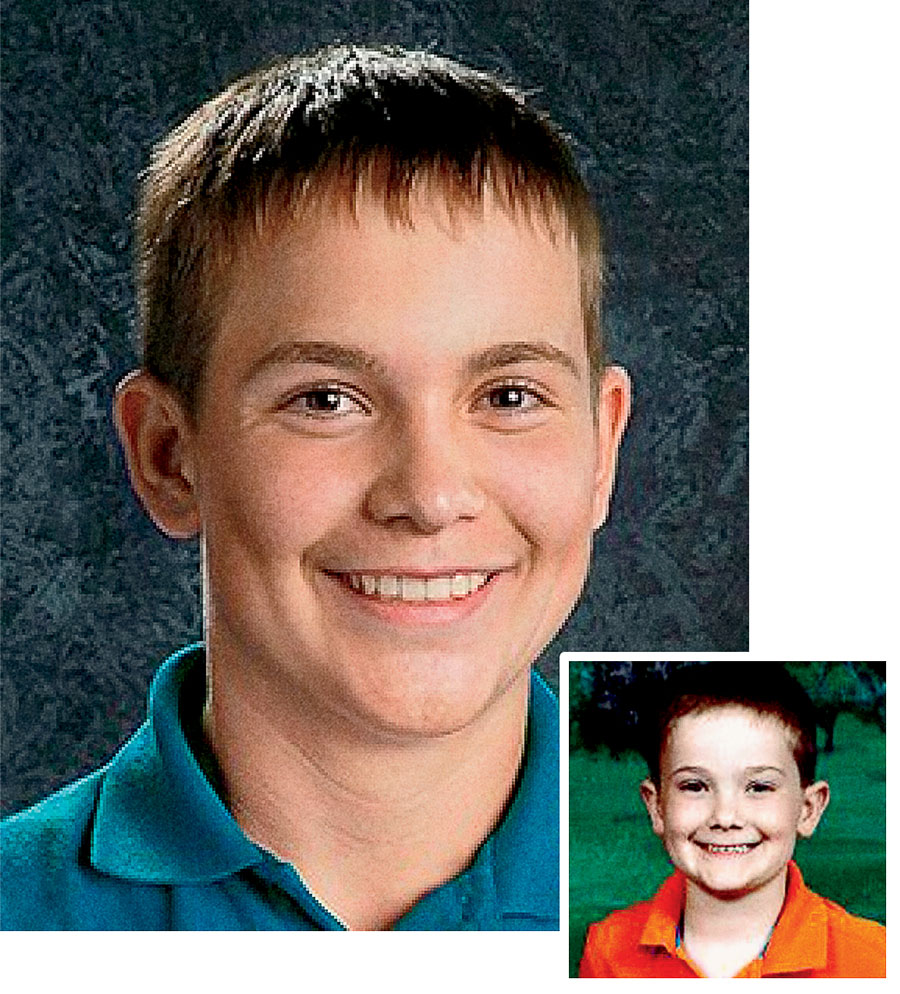
Jim didn’t know what to expect when he picked up his wife from the airport after the Bahamas trip. He was pleasantly surprised, however, when she climbed into the car and acted as if the argument about it had never happened. “She had a good time,” Jim recalls. “Things weren’t perfect, but she seemed back to normal.”
The following week, however, Amy came home early from her job, saying she didn’t feel well. Jim made arrangements to arrive late to work the next day so he could drive Tim to kindergarten, then drop off Amy at work.
Just before 8 a.m. that Wednesday, May 11, 2011, Jim, with Amy in the passenger seat, pulled in front of Greenman Elementary School, off Galena Boulevard in Aurora. “Tim hopped out of the back of the Jeep, waved, you know, ‘Love you, Dad,’ ” Jim recalls.
“Love you, too,” the father responded. “I’ll see you in a little bit.” He watched his son, in his T-shirt and green shorts, bound away, his Spider-Man backpack bouncing.
In the car outside Amy’s job, the couple kissed. “I said, ‘Love you.’ She said, ‘Love you, too,’ ” Jim says. “And then I just watched her go in the building.”
Jim headed to work for a bit. At about 10:30 a.m., at the end of the short kindergarten day, he eased his Jeep into the school parking lot and went inside to get his boy. A teacher at the check-in desk looked at him, puzzled. “What are you doing here?”
“I’m here to pick Tim up.”
“He left this morning.”
“What?”
“Can I see who signed him out?”
He looked at the signature.
Amy.
The mother had claimed there was an emergency, he was told.
Amy rarely reached out for help. That she did on this occasion must have meant she was hurting badly. Kara never dreamed it would be the last time she would talk to her sister.
Angry, Jim began calling Amy. No answer. He left a message. “What’s up?” he asked sharply. “Talk to me.” No return call.
He went back to work but couldn’t concentrate. Jim recalls thinking, “Goddamn it, Amy. Really? You’re just going to take Tim somewhere for the day without even telling me?” He took the rest of the afternoon off. Something was going on. She must still be angry about his objection to the trip, he thought.
This was not entirely out of the ordinary. When Amy was especially upset, Jim says, she’d take off for a couple of hours or longer. She’d drive somewhere to clear her head. What was unusual this time was that she took Tim with her.
Jim calmed himself and left Amy another message: “Hey, I’m not mad anymore. Just tell me what’s going on.”
Hours passed. Jim grew increasingly concerned. He began making phone calls. One was to Kara. “Have you heard from her?” he asked. She hadn’t. “I’m sure it’s fine,” she told him. She, too, knew of Amy’s penchant for taking off when she was feeling overwhelmed.
Even so, Kara’s mind flashed back to a call she had received from Amy two days earlier. The argument with Jim was still bugging Amy. “She obviously wanted to talk,” Kara says. “But I was late for something. I just wasn’t up to getting into something heavy at that moment. So I rushed her off the phone.” Amy rarely reached out for help. That she did on this occasion must have meant she was hurting badly. Kara never dreamed it would be the last time she would talk to her sister.
Jim had resisted his urge to call the police at first, still hoping he would hear from her. But there were too many elements that concerned him. For one, he discovered that Amy had not taken her pills with her and may not have been using them for several days: Full bottles sat in the medicine cabinet, untouched.
That evening, he contacted the Aurora Police Department. “Well, we have to give her a little more time,” an officer told him. “Another 24 hours at least.”
The next day, two officers showed up at his work. “They said, ‘OK, we’ll just take the missing persons report. Do you have a picture of the two of them?’ ” Jim thought a minute and then realized he had something that might work. “I went home and found a dot matrix photo of them at a Chuck E. Cheese and said, ‘This is the best I can do off the top of my head.’ They said, ‘OK, we’ll file this, and if something else happens, we’ll get back to you.’ ”
Friday afternoon, Amy finally reached out. She called her mom, who then phoned Kara. “Everything’s fine,” their mother told her. “She was upset and she just needed some time alone.” Recalls Kara: “We all kind of breathed a sigh of relief, like, OK, she’ll be coming home soon.”
One of Amy’s next calls was not to Jim, but to his older brother. Puzzled and concerned, Chuck asked her to phone Jim. A father had a right to know where his wife and child were, he told her. Amy’s reply struck the brother as disturbing: “Tim is my son, and I can do what I want.”
As soon as he hung up, Chuck phoned Jim, who frantically tried calling his wife again, three times. No response. He would later learn that she had attempted to contact him at one point, but the call didn’t go through. He thinks maybe that’s why she called his brother. But he doesn’t know for sure. He never will.
Early afternoon the next day — Saturday, May 14 — Jim heard a knock at his front door. When he opened it, he met two men in suits, both wearing grim expressions. “Can we come in?” they said. “We’re detectives with the Aurora Police Department. We have some information regarding your wife.”
Thank God, he thought as he let them in; they must have found Amy and Tim. He looked at the men, eager to hear the details.
“We found Amy deceased,” one of the detectives said.
Jim stared at him for a moment. He heard the words, but they didn’t register.
“What do you mean, deceased?”
The detectives explained that she had been found in a Rockford motel, dead of an apparent suicide.
Jim was still trying to make sense of the news when the next thought popped into his head.
“Where is Tim? Where is my son?”
The detectives looked at each other, then back at Jim. “We don’t know,” one said. “He wasn’t there.”
“We’re looking,” said the other.
The father stood there, numb. Amy was dead. Tim was missing.
“We will let you know more as soon as we can,” one of the detectives said, handing him his card.
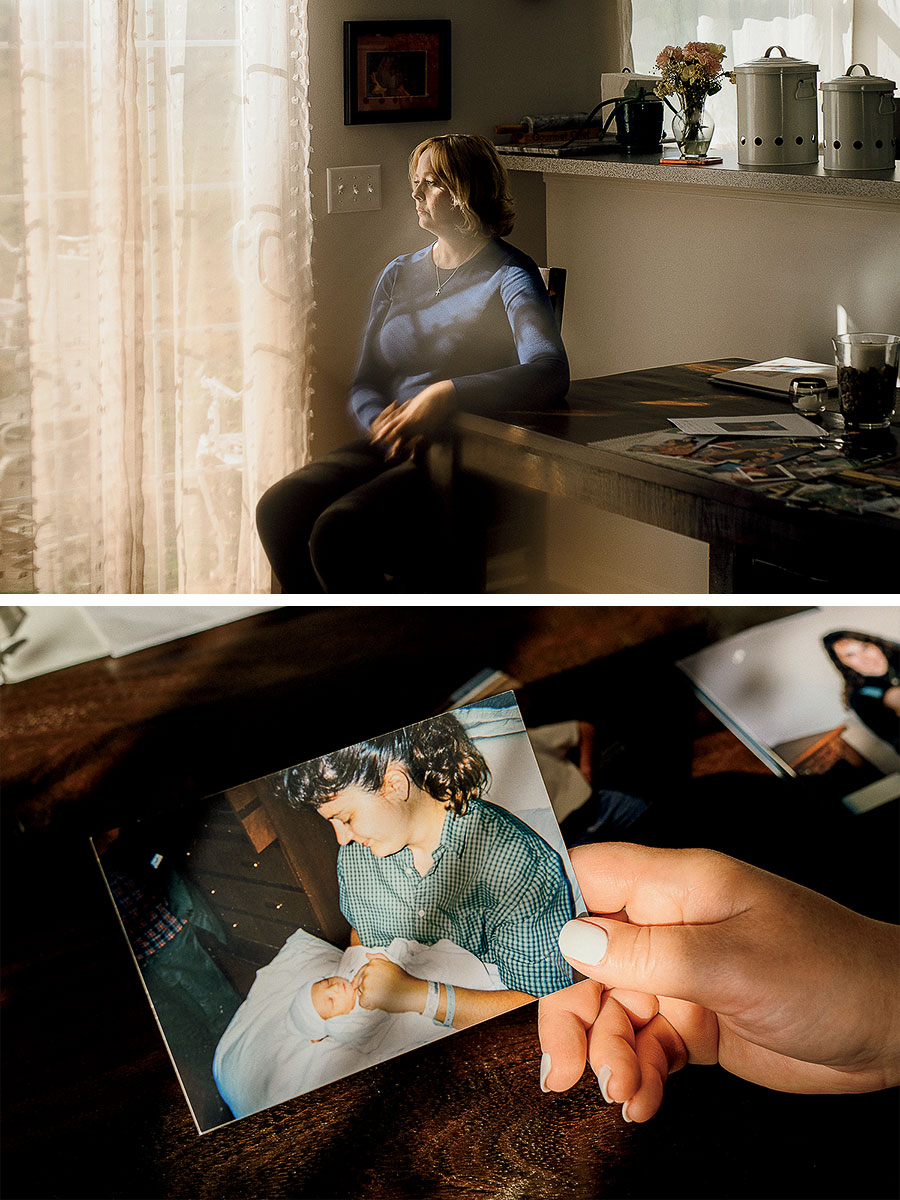
In the hours that followed, Jim learned about the suicide note Amy left in the motel room — a note the police have only ever paraphrased for the media. Two other letters written by Amy — one to her mother and one to the best friend who was with her on the Bahamas trip — arrived the next day, echoing the contents of the motel note.
“I’ve taken him somewhere safe,” she wrote to her mom. “He will be well cared for and he says that he loves you. Please know that there is nothing that you could have said or done that would have changed my mind.”
While investigators pored over these messages for clues, they also began reconstructing the last three days of Amy’s life. Using cellphone data, surveillance video, and I-Pass records, detectives were able to piece together a whirlwind 500-mile journey she took Tim on, covering six counties of Illinois and Wisconsin, with stops at two water parks and a zoo.
Almost immediately after Jim had dropped Amy off at work that Wednesday morning, she returned to Tim’s school in her own car, a blue 2004 Ford Expedition that she had left parked at her job. Surveillance video shows her walking through the school’s glass doors to the front desk at 8:15 a.m. About 20 minutes later, Tim appears in the lobby. Amy reaches out her hand for his, holds the front door open for him, and follows him outside.
At around 10 a.m., she pulled into an auto repair shop in La Grange, which suggests she knew she’d need her SUV in good shape for the hundreds of miles she planned to drive. She was told the repairs would take a few hours. One of Tim’s favorite places, Brookfield Zoo, was not far away, and a mechanic dropped the mother and son off there. They returned to the shop in the afternoon to pick up the SUV and then drove a little more than an hour north to the KeyLime Cove Water Resort (now the Great Wolf Lodge) in Gurnee. They spent the night there, ignoring the increasingly panicked texts and voicemails from Amy’s family.
The next day, Thursday, they headed to the Kalahari Resort in Wisconsin Dells, stopping along the way on I-94 to get gas and drinks. They also stopped at a convenience store to buy Tim clothes, a toy car, and a craft kit. At this point, Amy still hadn’t returned any messages.
The mother and son checked out of the resort the next morning. Surveillance video captured them waiting at the counter: Amy holds Tim’s hand and glances inside his Spider-Man backpack, which she’s carrying. Tim fidgets, bored. Nothing seems out of the ordinary. These images, though, are the last known sighting of Timmothy Pitzen.
Amy drove south on I-39, then west on I-88, for about 170 miles. At 12:30 p.m., she stopped and, over the next hour and a half, made the calls to her family and friends. Those she phoned felt reassured. Tim could be heard in the background in some calls, at one point saying he was hungry. Amy even put him on the line briefly with Jim’s brother.
Whatever happened to Tim almost certainly occurred in the hours following those calls. Immediately after she hung up, Amy turned off her phone and drove south along the Rock River to Sterling, Illinois, a small manufacturing and steel town surrounded by farmland, about 80 miles west of Aurora. Why she went there is a mystery to her family. They were not aware she had any acquaintances in Sterling. But Amy’s I-Pass history showed that months earlier she made two trips to the Sterling area, which she never mentioned to Jim or any other family member. Could she have been scouting a rendezvous point to hand off Tim? Meeting with the people she would entrust him to? Both were possibilities. Investigators consider this one of their few solid leads.
Amy’s exact whereabouts for the next several hours are unknown, but at 8 p.m., she resurfaced. A surveillance camera captured her, alone, at a Sullivan’s Foods in Winnebago, near Rockford. The footage shows her paying for stationery and envelopes, presumably to write her last notes.
She checked into the Rockford Motel between 11:15 and 11:30 p.m. Her body was discovered by a maid at 12:30 p.m. the next day. The door had been locked with the security chain, but the maid was able to open it enough to see Amy’s body. Under the bed, police officers found the box cutter she’d used to slash her wrist and neck. They also found a partially consumed bottle of Triaminic, a liquid cough and cold medicine for children, and Tim’s child identification card. Included in Amy’s note: a message to the motel staff that she was sorry they would have to clean up after her.
The media seized on the story immediately. Satellite trucks rolled up to Amy and Jim’s home in Aurora and that of Amy’s mother in Antioch. “Dead Mom, Missing Boy, Remains a Mystery,” read a headline in the Chicago Sun-Times. “Search Spans Three States for Boy From Aurora,” the Chicago Tribune announced.
Investigators were encouraged that neither Tim’s backpack nor the toys his mother had bought him, including a Hot Wheels starter set and a toy truck, were found in the motel — a sign they might still be with Tim. The next day, scores of law enforcement officials from the Aurora Police Department, the FBI, the U.S. Marshals Service, and other agencies conducted the first of their ground searches, scouring rural roads and parks along the I-88 and I-39 corridors near the Sterling area for clues to Tim’s whereabouts. Nothing turned up.
Investigators papered Amy’s route with fliers bearing Tim’s picture. Jim went on the local news to plea for Tim’s return. The National Center for Missing & Exploited Children was alerted, and Tim was added to its database. Potential sightings trickled in, but none panned out.
The following Friday, the wake for Amy was held at her place of worship: the Church of Jesus Christ of Latter-day Saints in Sugar Grove, Illinois. Family members and friends were still reeling. Recalls Kara: “I remember a lot of people she worked with and went to church with saying things like, ‘Amy would never kill herself. Something’s wrong here. We don’t believe this story.’ I just remember thinking, I don’t know what to tell you, but she did; clearly you don’t know her as well as you think you did.”
When Kara caught her first glimpse of Jim since her sister’s death, she saw a man dazed. “He barely moved during the entire wake,” she recalls. “He didn’t eat anything. He didn’t speak much. He just stood next to the casket. I remember thinking, Do you need to go to the bathroom or anything? Because he never moved from that spot. He was just totally numb. We all were.”
At one point, Kara approached Jim and asked if she could see her sister. “He knew what I meant. He took me over, and he pulled up the sleeve covering her right arm.” It had been wrapped to hide the deep slashes. Jim then gently drew down the scarf draped over the slits in his wife’s neck. Kara isn’t sure why she wanted to see the wounds. “I think I just wanted to see what she had done to herself.”
The funeral took place the next day at the same church. The media, not allowed inside, waited for mourners to emerge. The circus atmosphere made Kara realize how sensational the story had become. She imagined what her sister would think. “In her core, I think that Amy never felt like she was really all that important in life. She would be horrified to know that this has turned into such a big thing. I truly think she believed that everyone would just get over it and go on with their lives.” Despite everything, Jim had his wife buried beneath a headstone bearing the epitaph “Loving Mother.”
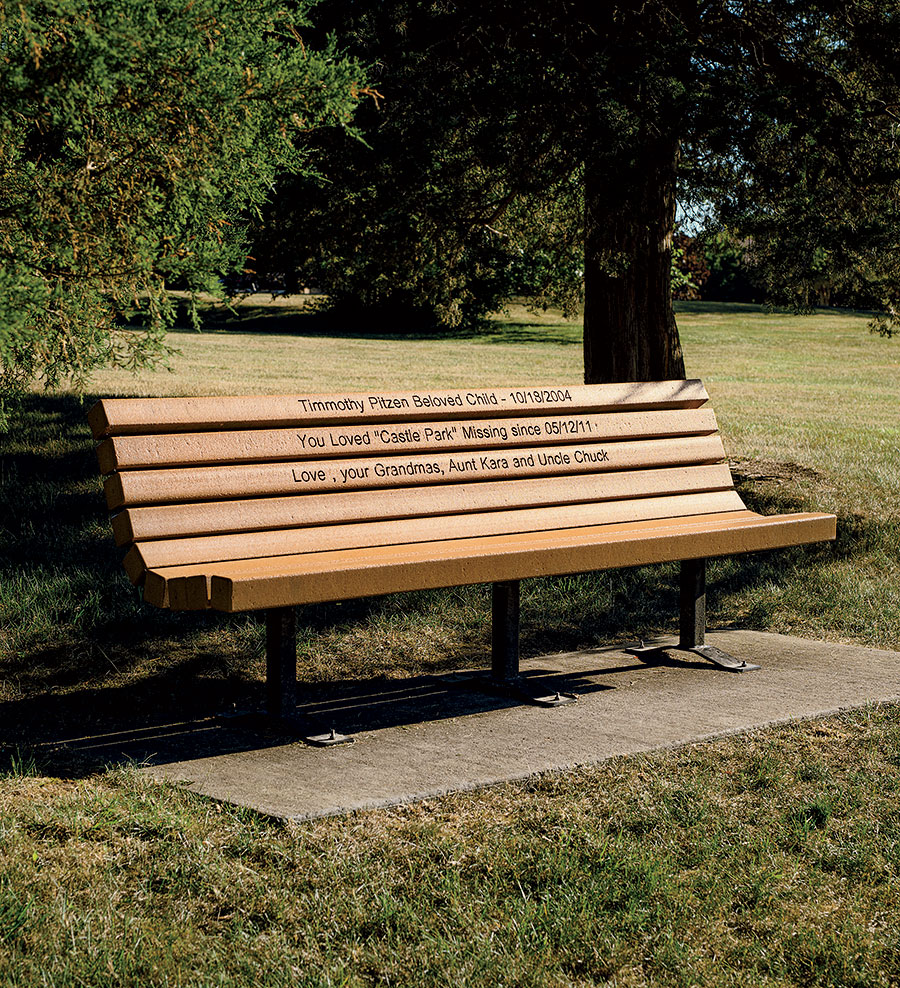
The investigation continued, but leads went nowhere. Three months in, the police confirmed that the blood they had found in the back seat of Amy’s SUV was Tim’s. On the surface, it appeared to be the first evidence that Amy may have harmed her son. But authorities accepted the family’s explanation that the blood was likely from a severe nosebleed the boy had in the vehicle not long before he went missing. Then, in late December, the police investigated a potential sighting of Tim at a Denny’s restaurant in North Aurora. But when they tracked down the car the boy had left in, it turned out he was the son of the driver. Another false lead. Another false hope.
Years passed. After Jim moved back to Clinton, he landed a job as a tooling designer at a tool, die, and machining shop in Eldridge, Iowa. He’s dated some, he says, but it’s hard. Things will be going great until the woman asks about all the photos of Tim on the wall, and he has to tell the story yet again.
Over time, Jim has learned to cope better with the constant torment of not knowing what happened to his son. Therapy has helped him learn to let go of part of his rage, to stop blaming himself — and Amy, to some extent, as he’s grown to understand that her depression was a dark hole she couldn’t escape.
Kara, meanwhile, spiraled downward. “I was lost,” she says. “I went through horrendous depression myself. I was not a good wife. I was not a good mother. I started drinking too much. I couldn’t sleep. I took anxiety medicine. It was miserable, honestly. I was just not in a good place for a whole lot of years.” Her struggles would eventually cost Kara her marriage. Then, about two years ago, she had an epiphany: “I can either let this ruin the rest of my life or let it mean something better.” She volunteered with Team Hope, a National Center for Missing & Exploited Children program that provides an emotional outlet for families of missing children, and she’s writing a book about her sister that she hopes to one day give to Tim to help him know and understand his mother.
On April 3, 2019 — nearly eight years into Tim’s disappearance — a woman in Newport, Kentucky, just across the Ohio River from Cincinnati, spotted a skinny young man who looked bruised and agitated pacing at an intersection. The woman would later describe the encounter to a local TV station: “He walked up to my car and he went, ‘Can you help me?’ He then said, ‘I just want to get home. Please help me.’ … He tells me he’s been kidnapped and he’s been traded through all these people and he just wanted to go home.”
When authorities caught up with him, he told detectives he had been held captive in Ohio by two men with tattoos who looked like bodybuilders. He was able to escape, he said, and run to safety across a bridge into Kentucky.
His name, he told them, was Timmothy Pitzen.
National news outlets descended on the small Ohio town where the young man was being questioned by the police. Though they said they had not yet determined whether he was actually the missing boy, several media outlets and even a police report gave the impression that Tim had likely been found.
All day, as they awaited the results of a DNA test, Jim, Kara, and the rest of the family agonized over the possibility that this was indeed Tim. “I completely got my hopes up,” Kara recalls. “I thought it was real, 100 percent. It just didn’t occur to me that it could not be him. I was thinking things like, Who’s going to pick him up? Does he need clothes? I’m, like, packing my stuff.”
Jim fought to keep his expectations in check. There had been so many false sightings over the years. Still, authorities were certainly taking this claim seriously. The Aurora detectives who had worked the case (both of whom declined to be interviewed for this story) were making the five-hour drive to Newport to check things out for themselves. But as more information emerged, Jim grew skeptical. The young man did know certain facts about the disappearance, but he wasn’t aware of more private details, like about the family cat and dog. When Jim asked why the police didn’t run the person’s fingerprints to see if they matched Tim’s, police said he had refused to cooperate. Then Jim saw a photo on TV — a grainy picture of the young man in a faded red hoodie, his hands buried in an army surplus jacket. “I thought, Maybe there’s a possibility it’s him, but I don’t think so.”
His suspicions were confirmed the next day when the DNA test came back. This was not 14-year-old Tim but an impostor: Brian Rini, a 23-year-old man with a history of psychiatric issues. Rini had gleaned details about the case from a 20/20 episode. When asked why he had claimed to be Tim, Rini, who would plead guilty to aggravated identity theft and be sentenced to two years in prison, told authorities he wished he had a father like Timmothy Pitzen’s.
For Kara, the news was devastating. At her mom’s house in Antioch, where she had been awaiting word, she put her head in her hands and sobbed. Then she thought of Jim. His mother had told her that he was shattered, holed up in his bedroom with the shades drawn to avoid the media clamor outside.

The rain has stopped outside Jim Pitzen’s house in Clinton. Despite the heartbreaking turn of events two years ago, he remains convinced Tim is still alive and will be found. He has a theory of what might have happened to him, one that he has shared with the police. He would rather not discuss it in detail, in case that tips off anyone involved.
As he keeps talking, however, he offers a general sense of how he thinks the events may have unfolded: that whoever took Tim raised him “off the grid,” in a remote area where the boy would be less likely to see news reports about his disappearance. Or perhaps those people took Tim overseas. For that reason, Jim granted an interview to a German television news program.
The Aurora Police Department and the National Center for Missing & Exploited Children also continue to operate under the assumption that Tim is alive. In May, the center released an updated age-progression image of what Tim might look like today, at 16. The resemblance to Jim is even more striking now: the chin, the dimples, the eyes, the smile.
The mystery haunts the center’s media director, Angeline Hartmann, who has taken a special interest in the case and all the theories about what might have happened to Tim. “This story is so bizarre and so intriguing because all of it is possible,” she says. “I would have conversations with the detectives, and I would say, ‘You tell me, what do you think?’ And they would say, ‘I go back and forth. Sometimes I believe strongly that he’s out there, and then sometimes I believe strongly that, nah, there’s no way.’ ”
Ultimately, Hartmann has come down on the side that Tim is alive and will be found: “This is what I tell people: No one would have ever believed that Jaycee Dugard was alive.” In that famous case, Dugard was found 18 years after being kidnapped at age 11 by a couple who concealed her identity.
It’s that kind of tale that helps keep Jim’s hopes alive. “It’s only going to take one person to figure out that that’s Tim,” he says. “One person is going to solve the case, say to Tim, ‘Hey, is this you?’ Then the cops are going to take over, and I’m going to ask two questions: Why did you do this? And why did you not bring him home?”
And what will he do on the day that he’s finally reunited with his son?
“Sit there and cry,” Jim says as the rain begins to fall again. “Just sit there and cry.” Maybe then, he hopes, he can be a father once more. Maybe then the dream that haunts him will finally end.



